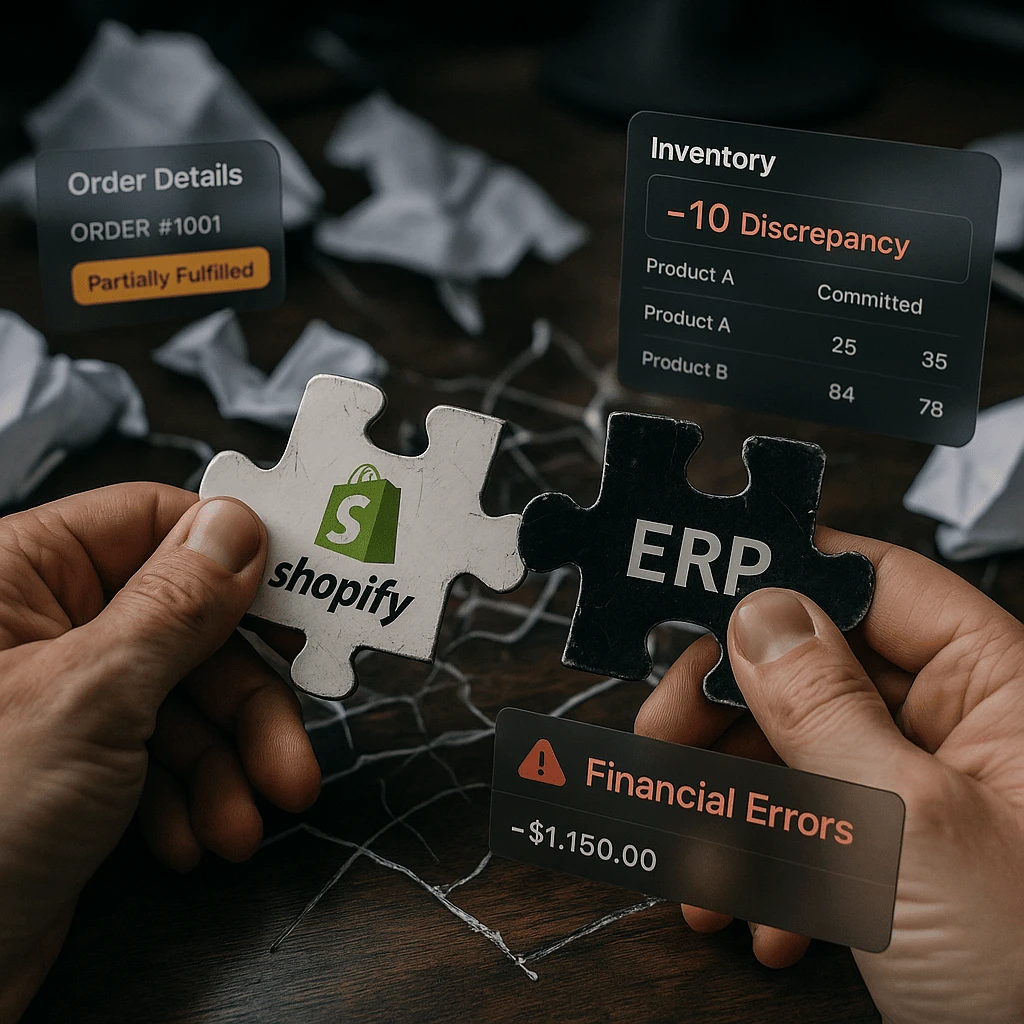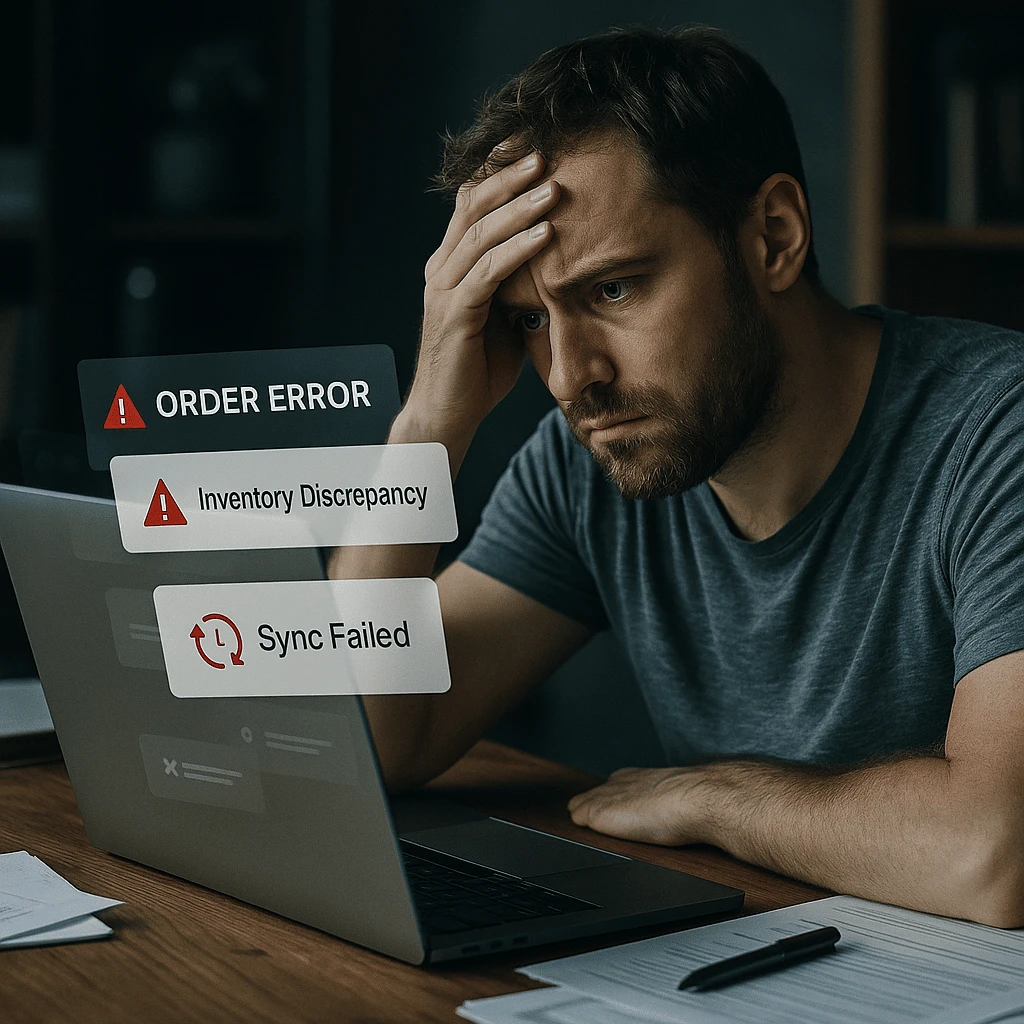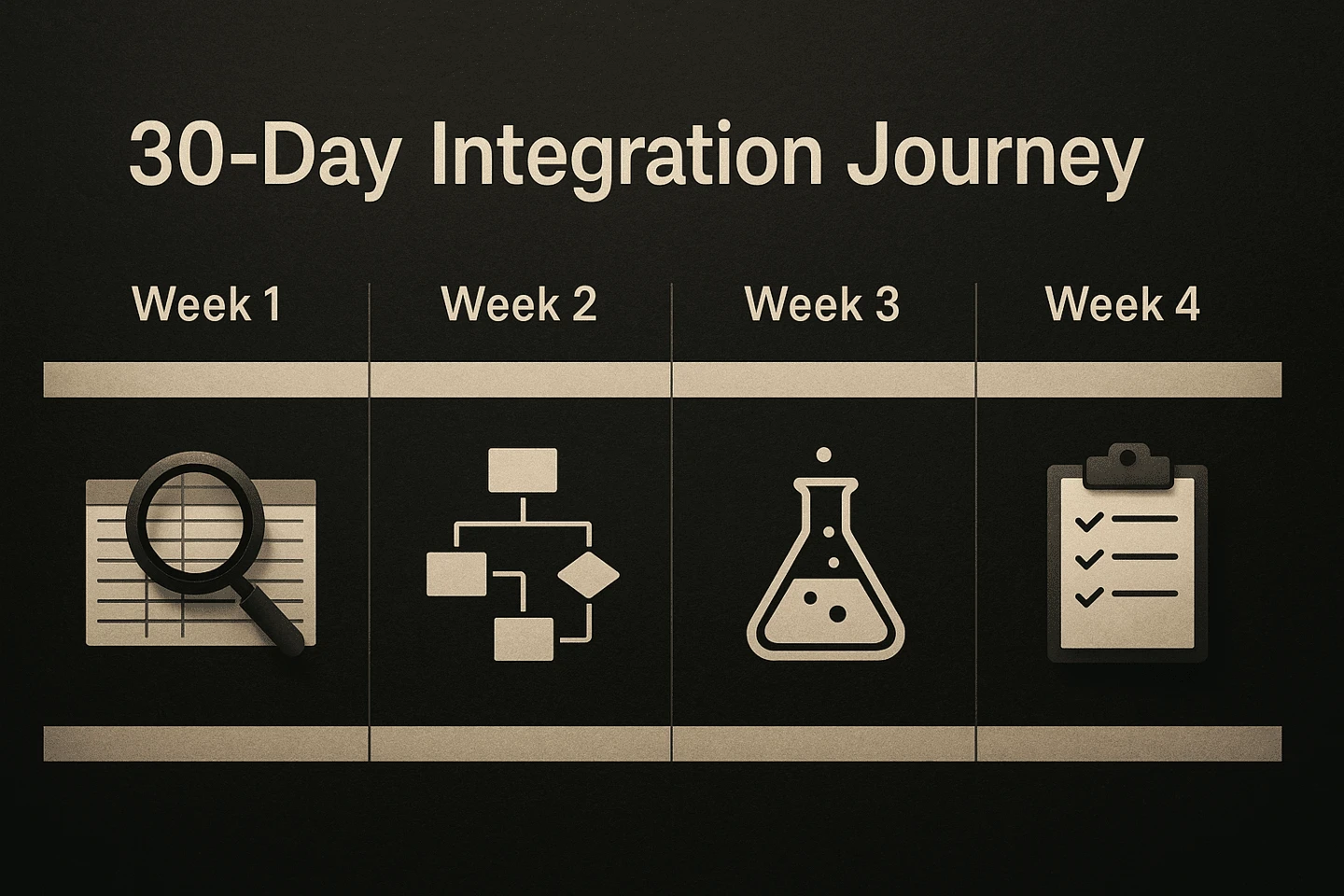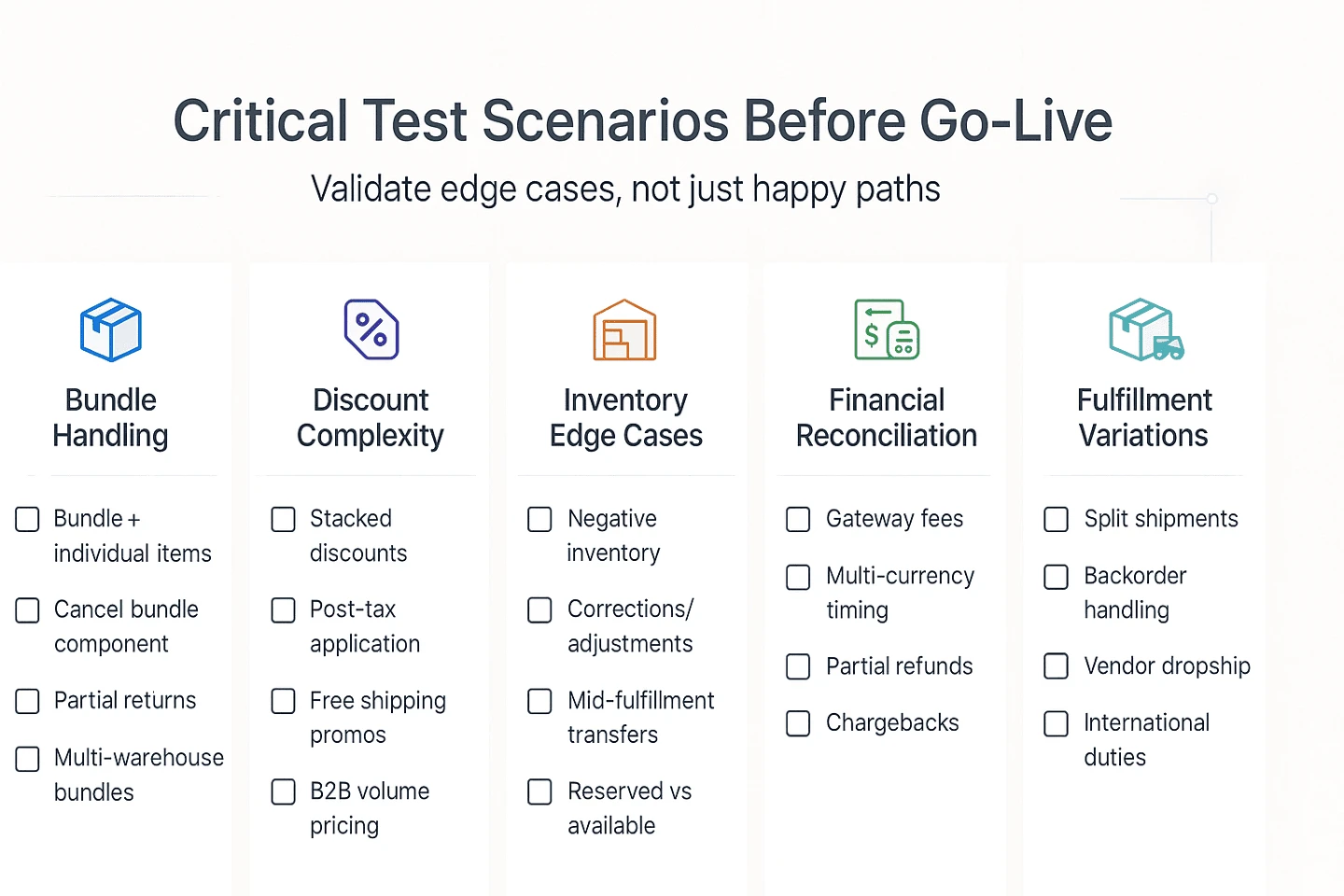Shopify NetSuite Integration: The Complete 2026 Guide
TL;DR: You can wire Shopify and NetSuite together in three ways: quick connectors, custom APIs, or a SaaS operations platform that unifies systems and becomes the foundation for new apps. If you're scaling, the third path keeps orders, inventory, and finance in lockstep and gives you room to grow without rebuilding.
Why this keeps breaking in real life
Day one: Your Shopify-NetSuite integration works perfectly.
Day two: A bundle order splits across three warehouses, the discount calculation doesn't match NetSuite's tax logic, and your finance team can't close the month.
That's not an integration problem. That's an operations problem wearing an integration hat.
Deloitte found that 13% of total B2B sales are lost, on average, due to negative customer experiences tied to outdated or disconnected systems, while only 17% of companies consider their online purchasing process “very easy.”

Whether you're selling solar equipment with complex kit configurations, building supplies with bulk pricing tiers, or running a multi-brand fashion business with seasonal inventory, the complexity compounds. Good Shopify NetSuite integration doesn't just push orders.
It respects business rules: how items are modelled, how fulfilments stage through the warehouse, how tax and rounding should behave, and who gets to approve what. Miss those, and your data will look tidy until it doesn't.
Research supports this operational reality. A 2021 academic study by Santos and Martinho found that ERP-reliant businesses often struggle to synchronise stock, order, and financial data across heterogeneous systems. The authors concluded that adopting a middleware architecture, serving as a unifying layer between ERP and ecommerce platforms, can significantly reduce integration maintenance costs and improve data consistency over time.
If you've ever watched a stock count go negative while a customer's order confirmation email is already sent, you know the special kind of panic we're talking about. There's a unique joy in discovering your "temporary" spreadsheet workaround just celebrated its third birthday.

Red flags your integration isn’t working
If you're experiencing any of these, your integration has become a liability rather than an asset:
- Finance reconciles orders manually every month-end
- Month-end close takes more than 3 days
- Your team checks sync status multiple times daily
- Exception handling has become someone's full-time job
Sound familiar? You're not alone. These are symptoms of integration that handles the happy path but breaks under operational reality. The three approaches below address these failures in fundamentally different ways.
One outdoor equipment retailer we worked with was manually reconciling 300+ orders daily across their D2C site and wholesale portal. That burned 6 hours every day just on data entry and verification. After implementing proper Shopify NetSuite integration with workflow controls, they cut month-end close from 5 days to 1.5 days and freed their finance team to focus on cash flow optimisation instead of Excel gymnastics.
The three ways to connect Shopify and NetSuite (and the trade you’re making)
Point connectors: Fast start, rigid future
Point connectors are the fastest out of the gate. If your flows are simple (single warehouse, vanilla fulfilments, minimal finance nuance) they're fine. The limitation appears when the business evolves. You can't ask a rigid mapping to understand exceptions you didn't model.
The plugin promised to solve everything. It solved three things and created seven new problems. Math checks out.
Best for: Sub-500 orders/month, standard product types, single warehouse, straightforward accounting.
Custom APIs: Total control, ongoing maintenance
Custom APIs give you total control. If you've got engineering capacity and appetite for ongoing maintenance as schemas and auth models change, you'll get exactly what you want. The risk is knowledge silos and a queue of "just one more tweak" requests that never ends.
Best for: Unique business logic, existing development team, budget for $50k-150k upfront plus ongoing maintenance
SaaS operations platform: Backbone for growth
A SaaS operations platform (Exsited's lane) sits between systems as the operational backbone. It standardises orders, items, customers, invoices, and payments; handles the workflow logic (approvals, cancellations, returns); and exposes clean integrations to both Shopify and NetSuite. The bonus: once your backbone is stable, you can add portals and forms (B2B ordering, RMAs, onboarding, compliance) without starting from scratch.
Best for: Growing businesses, multi-channel operations, plans to add B2B or custom workflows, need for operational visibility.
Major Shopify NetSuite integration platforms
Understanding the connector landscape helps you match solution to situation. Sure, your vendor said the integration would be "plug and play." They just didn't mention which decade.
Full disclosure: We're Exsited, and we'll cover our platform alongside alternatives.
| Platform | Pricing | Best For | Key Strength | Main Limitation | Setup Time |
| Native Shopify Apps | $500-800/mo | <500 orders/month, simple workflows | ✅ Quick setup, basic sync | ❌ Struggles with bundles, complex pricing | 2-4 weeks |
| Celigo | $800-2,500+/mo | Large catalogues, complex workflows | ✅ Handles edge cases, scalable | ⚠️ Requires technical knowledge | 4-6 weeks |
| Boomi | $2,000+/mo | Multi-system enterprise landscapes | ✅ Enterprise-grade iPaaS | ⚠️ Overkill for Shopify-NetSuite alone | 6-8 weeks |
| FarApp | $800-1,500/mo | Multi-channel inventory focus | ✅ Good Amazon integration | ❌ Less flexible workflows | 3-4 weeks |
| Exsited | Custom pricing | Growing businesses, B2B expansion | ✅ Operations platform + portals | ⚠️ Higher monthly cost | 4-8 weeks |
For detailed feature matrices, vendor selection criteria, migration scenarios, and TCO analysis per platform, see our NetSuite Shopify Connector 2026 Comparison.
Exsited (Operations Platform)
Not just a connector. A complete operations platform that synchronises Shopify and NetSuite while providing the foundation for custom portals, workflows, and business applications.
Pricing: Custom based on transaction volume and feature requirements
Best for: Businesses needing both integration and operational workflow capabilities, those planning B2B expansion or custom portals
Differentiator: Becomes infrastructure for future operational needs beyond basic sync
See our detailed connector comparison: NetSuite Shopify Connector 2026 Comparison

What "good" really looks like
When Shopify NetSuite integration works properly, your team stops thinking about it. That's the bar.
Finance closes the month in a day and a half instead of five, with confidence the numbers are right. Operations knows which warehouse fulfils which order without checking three systems. Customer service sees the complete order history (original sale, modifications, fulfilments, returns) in one view that tells a coherent story.
A 2025 EY case study on Diamondback Energy shows how this plays out in practice. After implementing SAP S/4HANA with EY’s hybrid-agile methodology, the company reduced month-end close times by 30% and achieved a 25% faster year-end closing. EY’s findings underscore that modern ERP systems deliver ROI only when integrated cleanly with finance and operations workflows, a principle that applies directly to NetSuite-Shopify integration.
Good integration feels invisible until you need it. Then it shows you exactly what happened, when, and why, with timestamps, transforms, and approval trails you can replay six months later when finance asks "how did we account for that bulk discount?"
💡 Insight: If you can't replay a sync with full transforms and timestamps, you don't have an integration. You have a hope.
Implementation checklist: Your first 30 days

Getting Shopify NetSuite integration right requires methodical preparation, not rushed deployment.
Here's the proven sequence:
Week 1: Data Quality Audit - Standardise SKUs between systems (case-sensitive, no extra spaces), clean duplicate customer records, map GL codes from Shopify product types to NetSuite income accounts, verify tax configuration alignment, reconcile payment gateway methods to deposit accounts.
Week 2: Workflow Mapping - Document order-to-fulfilment flow including 3PL routing, define inventory reservation vs committed vs fulfilled states, determine invoice timing (at order/shipment/delivery), map return reasons to credit memo types, align payment settlement with revenue recognition.
Week 3: Configure Staging Environment - Set up NetSuite sandbox and Shopify development store (never test in production), test bundles/discounts/partial shipments/cancellations/refunds, verify error notifications trigger correctly, confirm system handles peak order volumes, review API credentials and audit logging, ensure every sync logs source data, transformations, and timestamps for replay.
Custom field mapping: where optimism goes to die. The businesses that succeed treat staging as seriously as production. Edge cases aren't edge cases at scale—they're Tuesday morning.
Week 4: Parallel System Run - Run new integration alongside existing process with daily reconciliation, document every sync failure and resolution, train ops team on new workflows and troubleshooting, prepare rollback plan for critical issues, make go/no-go decision based on error rate thresholds.
Common mistake: Rushing to production after only testing happy-path scenarios. The edge cases (the ones that break at 2am on a Saturday) are what determine success.
💡 Pro tip: The businesses that succeed with integration are the ones that treat Week 1 as seriously as Week 4. Data quality determines everything that follows.
For implementation walkthroughs comparing connector vs API vs platform approaches, plus field mapping strategies and solutions to common integration failures, see How to Connect NetSuite to Shopify: Complete Implementation Guide.
How Exsited approaches Shopify NetSuite integration
Exsited is a SaaS operations platform that unifies business systems and provides the foundation for new digital applications and platforms. In practice, that means we treat Shopify and NetSuite as peers connected through an operational model that belongs to you, not to a plugin.
We map your finance rules deliberately. GL and tax codes, fees, and settlement timing, so accounting agrees with operations.
We model items and inventory the way you actually sell: variants, kits, bundles, preorders, backorders, and multi-warehouse realities. This matters when you're managing product bundles for home improvement retailers, coordinating dropship and warehouse inventory for electronics, or handling pre-orders for limited edition releases.

We run workflows with role-based approvals and audit trails, so exceptions aren't ad-hoc email threads. They're controlled decisions.
We expose the same backbone to custom portals and forms, so adding a wholesale portal or an RMA flow is an extension, not a rebuild.
The result isn't just NetSuite Shopify integration; it's operational coherence. Your team stops firefighting and starts improving cycle time.
Choosing the right approach for your business
Most integrations don't fail because they're broken. They fail because they can't evolve.
Your business changes faster than your integration can adapt. A new warehouse next quarter. B2B pricing by mid-year. A second brand or international expansion within 18 months. Each change shouldn't require rebuilding your integration from scratch.
Durability questions to ask
Before choosing an approach, ask yourself:
- Can it handle customer-specific pricing without custom development?
- What happens when you add a second warehouse or 3PL provider?
- Will a Shopify API change cause 48 hours of downtime and emergency fixes?
- Can you add a wholesale portal without starting over?
- Will your team still trust it in 18 months, or will you be evaluating replacements?
The best integrations aren't the fastest to deploy. They're the ones that grow with your business without requiring constant rebuilding or workarounds.
As McKinsey & Company observes, companies that unify digital and IT operations into an integrated technology model are 60% more likely to see their technology investments translate into business value. Integrated “product-and-platform” architectures—like those underlying modern SaaS operations platforms—reduce fragmentation and improve adaptability as new systems come online.
💡 Insight: Point connectors lock you into rigid mappings. Custom APIs create maintenance debt. Operations platforms provide the extensible backbone that accommodates growth without architectural rewrites.
Three starting points based on your pain
Start with finance reconciliation if month-end close takes more than 3 days or revenue recognition causes audit headaches. Begin with order to invoice to payment, stabilise finance first, then widen to inventory.
Start with inventory control if frequent overselling or stock discrepancies plague operations. Make NetSuite your inventory truth, publish availability to channels, and let reservations behave predictably.
Start with multi-channel expansion if growth means new revenue motions. Keep Shopify for D2C, add B2B portals, and let NetSuite remain as finance master. One backbone, multiple front doors.
Total Cost of Ownership: The 24-Month Reality
The upfront price tells only part of the story. Here's what each approach actually costs over 24 months:
| Cost Factor | Point Connector | Custom Build | Operations Platform |
| Initial Setup | $2-5k | $50-150k | $10-20k |
| Monthly Platform | $500-2,000 | $0 (self-hosted) | $2,000-5,000 |
| Maintenance/Year | Included | $30-60k (dev time) | Included |
| Exception Handling | ~$8k/month (manual labor) | Minimal (if coded) | Minimal (workflow-based) |
| Customisation | Limited/expensive | Full control | High flexibility |
| 24-Month Total | $54-97k | $110-270k | $58-140k |
Hidden costs people miss:
Manual exception handling: Every order that breaks the mapping requires human intervention. At scale, this becomes a full-time role.
Upgrade cycles: When Shopify or NetSuite releases breaking API changes, someone must fix your integration.
Business process changes: New warehouse? New product type? New return policy? Each requires integration updates.
Opportunity cost: What revenue could your team generate if they weren't reconciling orders?
💡 Insight: Price your solution on time-to-resolution for exceptions, not just "time to first sync." That's where ROI actually lives.
Shopify Plus NetSuite Integration: Enterprise Quirks worth Naming
If you're on Shopify Plus NetSuite integration, expect higher stakes: complex discounting, large catalogues with kits and assemblies, multiple fulfilment nodes, SSO and RBAC across teams, and stricter audit needs. Think outdoor brands managing D2C and dealer networks, wholesale suppliers running trade alongside retail, or multi-brand portfolios sharing inventory.
Enterprise operations require multi-entity routing, manager-level approval workflows, and compliance audit trails that trace every transaction from Shopify order to NetSuite journal entry. Platform-level workflow and replayable logs move from "nice" to "non-negotiable."
For enterprise-specific implementation patterns, governance models, and compliance frameworks, see Shopify Plus NetSuite Integration Enterprise Playbook.

Your test plan (the one people skip)
Before you call anything "live," rehearse the ugly stuff: cancellations after partial ship, multi-currency refunds, bundle breaks, negative inventory corrections, and bulk updates under rate limits. Add your industry-specific edge cases: warranty replacements for electronics, seasonal returns in fashion, or split shipments for oversized building materials.
Critical test scenarios
Bundle handling:
- Order bundle + individual items, then cancel one component
- Return partial bundle from multi-warehouse fulfilment
- Process bundle where components have different tax treatments
Discount complexity:
- Stack product + order + customer-specific discounts with tax
- Apply volume pricing tiers for B2B with promotional overlay
- Handle free shipping scenarios across multiple fulfilment methods

Inventory edge cases:
- Overselling scenario with negative inventory correction
- Mid-fulfilment warehouse transfer with order reservation
- Return processing with damaged goods vs restockable logic
Financial reconciliation:
- Payment gateway fees, settlements, and GL account mapping
- Partial refunds affecting tax and discount allocation
- Credit card chargebacks with NetSuite credit memo creation
If the system can narrate each of those moves in plain language (and your finance team nods) you're ready. Will this catch every possible scenario? No. Will it catch the ones that would otherwise wake you up at 2am on a Saturday? Yes. We've earned that knowledge the hard way.
Common questions about shopify netsuite integration
How long does Shopify NetSuite integration take?
Point connectors: 2-4 weeks for basic setup, assuming clean data and standard workflows. Add 2-4 more weeks if you need custom field mapping or have data quality issues to resolve first.
Custom APIs: 2-3 months for initial build, plus 2-4 weeks of parallel testing. Ongoing maintenance requires dedicated development resources.
Platform approach: 4-8 weeks including workflow setup, testing, and team training. Longer timelines typically reflect complex business rules, not platform limitations.
Reality check: Anyone promising "integration in 48 hours" is either selling a demo that doesn't handle your edge cases, or about to make your operations team very unhappy.
What's the typical cost range?
Connectors: $500-2,000/month subscription plus $2-5k setup. Budget an additional $8k/month in labour if you're manually handling exceptions at scale.
Custom build: $50k-150k upfront development plus $30-60k annually in maintenance and updates. Only economical if you have very unique requirements and existing development team.
Platform approach: $2,000-5,000/month depending on transaction volume and feature requirements, plus $10-20k implementation. ROI comes from eliminating exception-handling labour and enabling new revenue channels.
The math that matters: Calculate total cost over 24 months, including hidden labour costs for exception handling and data reconciliation. The cheapest option upfront is rarely the cheapest option at scale.
Can I integrate Shopify with ERPs other than NetSuite?
Yes. Most integration platforms support multiple ERP systems:
Odoo: Open-source ERP popular with mid-market retailers
SAP Business One: Enterprise ERP scaled for smaller operations
Microsoft Dynamics: Strong in wholesale and distribution
Acumatica: Cloud ERP with good ecommerce capabilities
MYOB/Xero: Accounting systems that function as lightweight ERPs for SMEs
The integration principles remain the same (map orders, sync inventory, reconcile finances), but each system has unique data models and business logic.
What happens when Shopify or NetSuite updates their API?
With connectors: Vendor handles updates (in theory). In practice, you may experience sync failures until they patch their code. Budget for 1-3 days of disruption per year.
With custom builds: Your team must monitor API deprecation notices and update code accordingly. This is ongoing technical debt.
With platforms: Platform vendor manages API changes across all customers. You benefit from their scale. They have to stay current to serve hundreds of clients.
Risk mitigation: Always use API versioning, maintain staging environments, and never auto-deploy updates to production without testing.
Do I need technical expertise in-house?
Connectors: Minimal technical knowledge required for setup, but you'll need someone who understands both Shopify and NetSuite data structures to troubleshoot issues.
Custom builds: Absolutely. You're building software. Expect to need full-stack developers familiar with both platforms' APIs.
Platforms: Operations-focused setup rather than code-focused. You need business analysts who understand your workflows, not necessarily programmers. Technical support from the platform vendor handles complex scenarios.
Ideal team: Operations manager (owns workflows) + finance person (owns accounting logic) + technical point person (troubleshoots edge cases). See Week 4 of the Implementation Checklist for detailed team responsibilities during parallel system run.
Where to next
Still comparing Shopify NetSuite integration platforms at 2am? We respect the dedication, but there's a better way.
If you're evaluating options, compare the connector landscape honestly and note where their opinionated mappings help or hurt. If you're hands-on, look at three implementation patterns side-by-side and choose the one that aligns with your constraints. If you're ready to stop duct-taping, put a backbone in place and build forward.
Deep dive: NetSuite Shopify Connector 2026 Comparison (objective overview of connector options and when they fit)
How-to: How to Connect NetSuite to Shopify (3 Methods Compared)
Scaling up: Shopify Plus NetSuite Integration Enterprise Playbook
And if you want to see how a SaaS operations platform changes the tenor of your day-to-day, let's set up a demo. We'll map your objects, walk your workflows, and show you how this becomes the foundation for whatever you build next.
References
Deloitte Digital (2023). Four B2B Commerce Trends that Separate Front Runners from the Pack.
EY (2025). Case Study: Diamondback Energy Implements SAP S/4HANA for Growth.
McKinsey & Company (2020). Products and Platforms: Is Your Technology Operating Model Ready?
Santos, M., & Martinho, R. (2021). Architectural Challenges on the Integration of e-Commerce and ERP Systems: A Case Study. DOI: 10.5220/0010494903130319
I can see it in the page source, but it is being ignored by Google. ChatGPT says to replace it with this instead:









